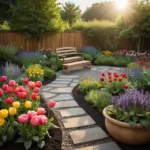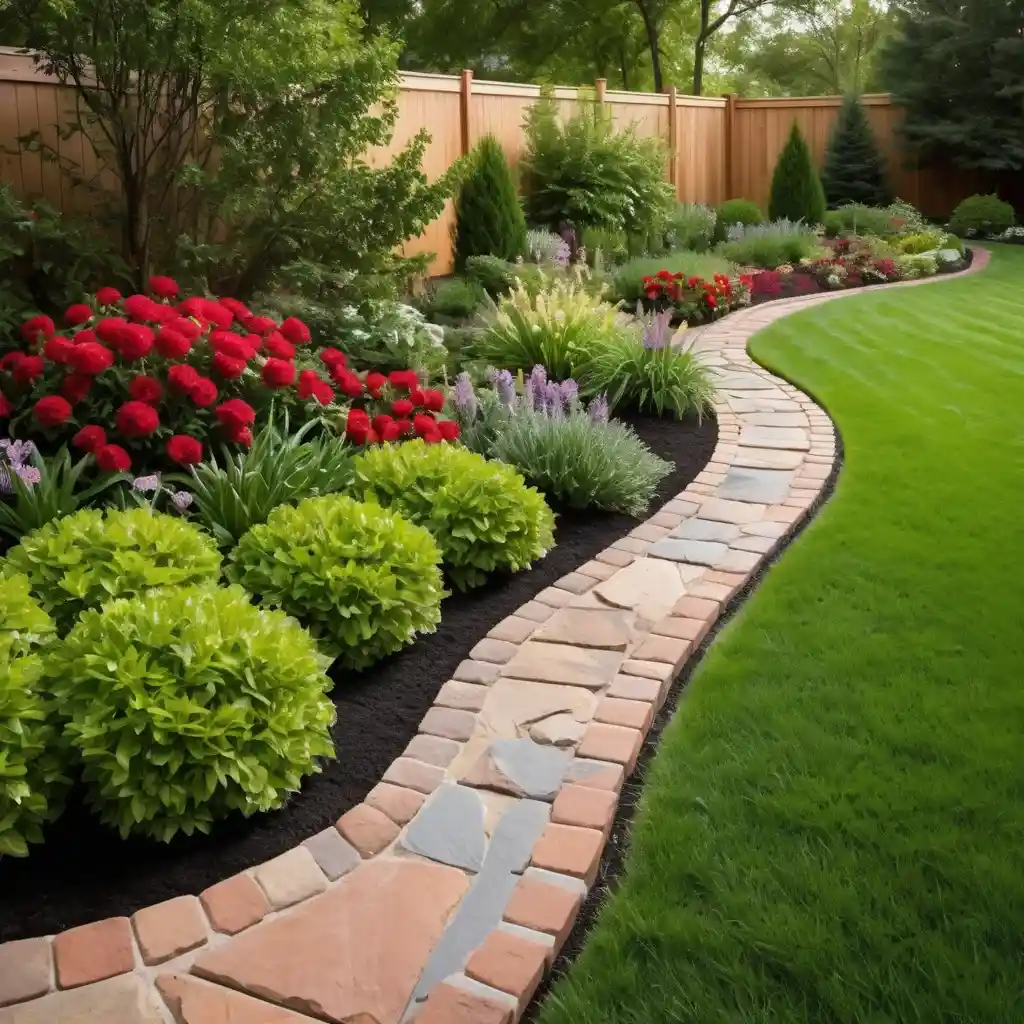Introduction
A garden edge can really make a difference when creating a beautiful garden. It’s not just about the plants and flowers; the right edge adds shape and organization, helping your plants stand out while keeping grass and weeds in check. Whether you want a clean, modern look or a more natural style, there are many ways to create great garden edges without spending too much.
In this article, we’ll show you simple and affordable DIY garden edging ideas. These ideas are easy to do, budget-friendly, and will make your garden look neat and attractive. Whether you’re new to gardening or have some experience, these ideas will help you turn your outdoor area into a beautiful, well-defined space.
Why Garden Edge is Essential for Your Garden
What is a Garden Edge?
A garden edge is like a border that separates your garden from the lawn or other areas outside. It’s important for both looks and function. A garden edge helps keep plants and flowers in place, stops grass from spreading into the garden, and makes it easier to see the different parts of your garden.
The Benefits of a Well-Defined Garden Edge
Having a sharp, neat garden edge offers several benefits:
- Visual Appeal: Garden edges give your space a polished, professional look.
- Prevents Overgrowth: A defined edge keeps grass and weeds from spreading into garden beds, making maintenance easier.
- Organization: It separates different sections of the garden, such as flower beds, vegetable patches, and walkways.
A garden edge isn’t just about beauty; it makes caring for your outdoor space more manageable and enjoyable.
Types of Garden Edging to Consider
Modern Garden Edging Stones
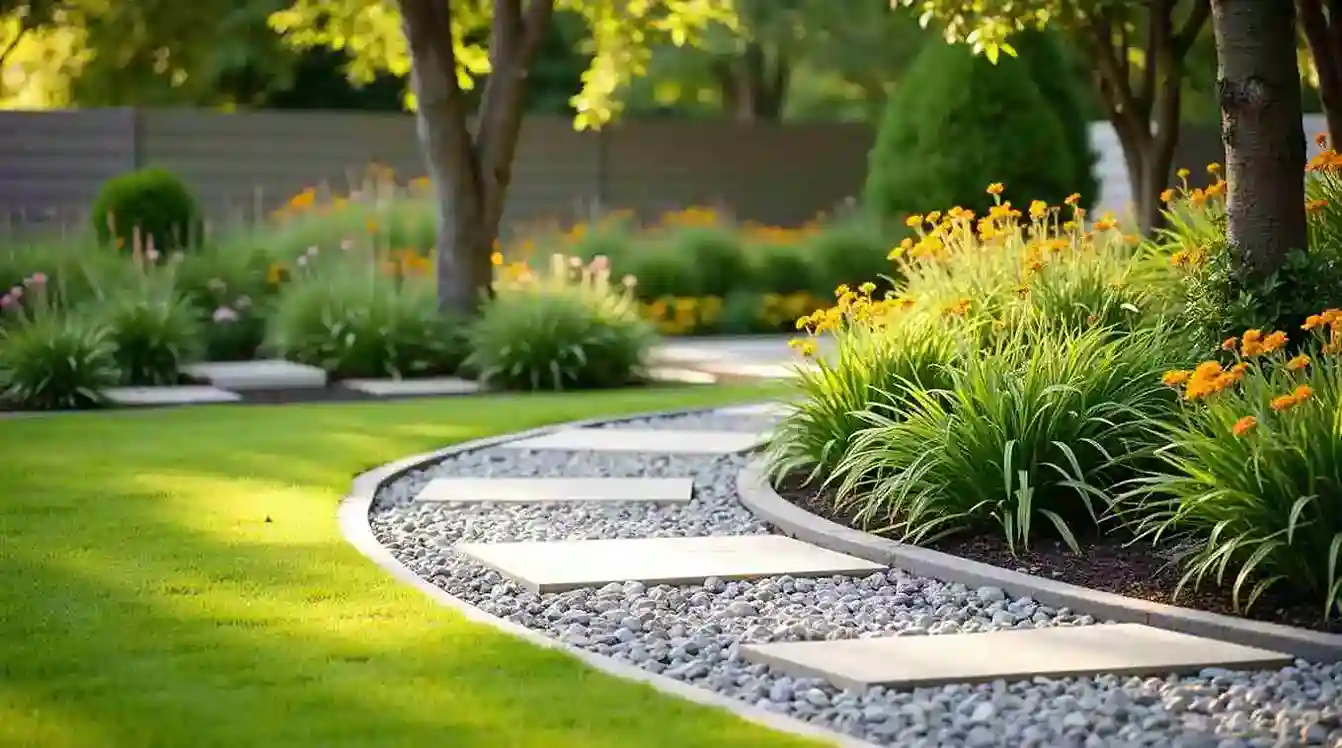
If you want a clean and stylish garden, modern garden edging stones are a great choice. They come in different shapes, sizes, and materials—whether you prefer classic brick, natural stone, or sleek concrete. Here’s why they’re a smart option:
- Durability: Stone edging lasts for years with little maintenance.
- Aesthetic Appeal: It gives your garden a neat, polished look, whether you prefer straight lines or gentle curves.
Installing stone garden edges is simple. Start by planning your layout, then place the stones along your desired path. Finally, secure them with mortar or landscape adhesive for a sturdy finish.
Concrete Garden Edging Ideas
Concrete edging is a budget-friendly and durable option for your garden. You can choose from ready-made blocks or go for poured concrete, which can be shaped to fit your design perfectly.
Here’s why it’s a great choice:
- Affordable & Versatile: Concrete edging blocks come in different shapes, including straight and curved, making it easy to match your garden layout.
- Strong & Long-Lasting: They can handle heavy foot traffic, so they’re ideal for busy areas.
Installing concrete edging is simple. Just arrange the blocks in your preferred pattern, then use a rubber mallet to gently tap them into place. Make sure everything is level and secure for a clean, polished finish.
Steel Garden Edging for a Sleek Design
Steel garden edging is a fantastic option if you want a sleek, modern look. Not only is it strong and flexible, but it can also be shaped into both straight lines and smooth curves, which makes it a great fit for any garden design.
Here’s why it stands out:
- Modern & Minimalist: It adds a clean, industrial touch to your outdoor space.
- Durable & Weather-Resistant: Steel edging holds up well over time, even in harsh conditions.
Installing steel edging is easy. To start, dig a shallow trench along your desired edge. Then, place the steel strips securely in position. Next, secure the strips with stakes or connectors to ensure they stay firmly in place.
Inexpensive DIY Garden Edging Ideas
You don’t need to spend a lot to create beautiful, functional garden edges. Here are some budget-friendly DIY projects to try:
Garden Edging Blocks
Garden edging blocks are versatile and can be stacked or arranged in different patterns to create a charming boundary for your garden beds.
- Steps:
- Lay out the blocks along the garden edge.
- Use mortar to hold them in place or simply stack them for a more casual look.
- Backfill with soil or mulch to keep them secure.
Plastic Garden Edging
Plastic garden edging is an affordable option that’s easy to install and maintain. It’s available in various colors and styles, so you can choose one that complements your garden’s design.
- Steps:
- Roll out the plastic edging along your desired border.
- Secure it with landscape staples or metal spikes.
- Trim excess plastic for a clean finish.
Eco-Friendly Garden Edging with Natural Rocks
Natural rock edging can give your garden a rustic, organic feel. You can often find stones in your yard or purchase them at a reasonable price from a local supplier.
- Steps:
- Gather rocks of varying sizes.
- Arrange them along the garden bed, pressing them into the soil for stability.
- Use smaller stones to fill in gaps between larger rocks.
Mulching Garden Bed Edging
Mulch is an excellent option for a garden edge because it’s easy to install, affordable, and serves multiple purposes. It suppresses weeds, helps retain moisture, and adds to the aesthetic appeal of your garden.
- Steps:
- Lay down a weed barrier fabric along the garden bed.
- Add 2-3 inches of mulch on top.
- For added definition, you can use edging materials like bricks or stones to hold the mulch in place.
Tools and Techniques for Perfect Garden Edge
Creating the perfect garden edge involves using the right tools and techniques. Here are some of the tools that can help:
Spade for Turf Cutting
To create a clean, sharp edge, a spade is one of the best tools you can use. It allows you to cut through turf and soil easily, giving you a defined border.
- Tips:
- Use a spade with a long handle to maintain a comfortable stance.
- Work slowly and carefully to achieve straight, smooth lines.
Half-Moon Edger
A half-moon edger is a curved tool that’s perfect for cutting precise, defined edges. It’s ideal for creating sharp borders and can be used on both straight lines and curves.
- How to Use It:
- Place the edger along the desired edge of your garden bed.
- Push down with the footrest to slice through the soil.
- Remove the soil and maintain the line by making small adjustments.
Black & Decker Edge Hog
If you have a larger garden, the Black & Decker Edge Hog can be a game-changer. This electric tool provides a continuous edging line, making it easier to create perfectly defined borders around your garden beds.
- Benefits:
- Provides consistent depth and precision.
- Reduces the time and effort spent on edging.
Hand Shears for Razor-Sharp Garden Edge
For smaller areas and finer work, hand shears are perfect for cutting grass or weeds along the edge of your garden. In fact, these shears will help you achieve razor-sharp, clean lines, giving your garden a polished and well-maintained look.
Here are a couple of tips to keep in mind:
- Trim the edges frequently to keep them neat and prevent overgrowth.
- Also, be careful not to trim too much of the plants or grass that you want to keep, as this can affect their health and appearance.
By following these tips, you’ll keep your garden edges looking sharp and tidy!
Creative Garden Edge Designs
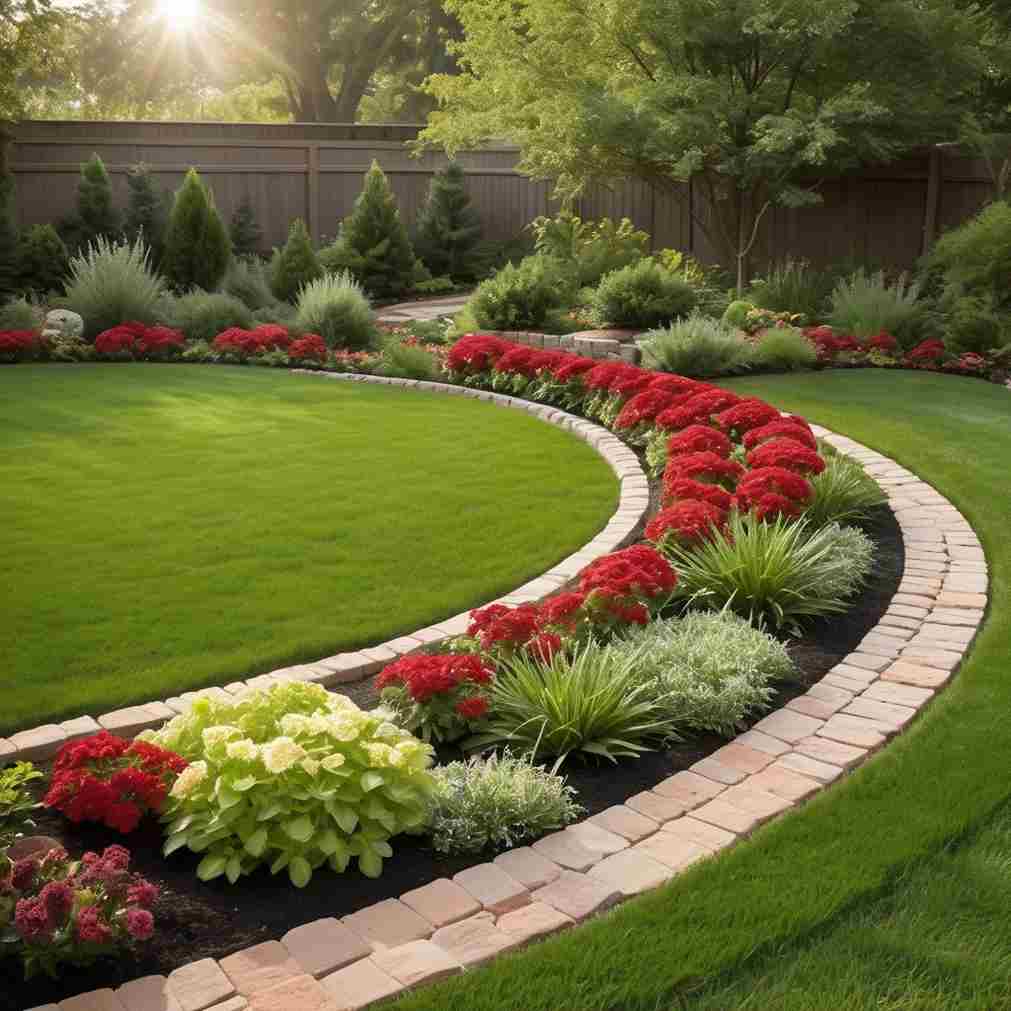
A creative garden edge can elevate the entire look of your garden. Here are a few unique garden edging ideas that will help you make a statement:
Raised Garden Bed Edge
organized look, and they also make gardening easier on your back since you won’t have to bend as much. Plus, they offer a clear and sturdy border that enhances your garden’s structure. You can build them using materials like wood, brick, or stone, depending on your style and needs.
Here’s how to set one up:
- First, pick a material for your raised bed that suits both your aesthetic and durability preferences.
- Next, stack the material to the height you desire, ensuring it’s sturdy and level.
- Finally, fill the bed with soil and start planting your favorite flowers or vegetables.
By following these steps, you’ll create a beautiful, functional garden that’s easy to maintain!
RELATED : DIY Raised Garden Beds: Build & Fill on a Budget
Using Bricks for Classic Garden Edge
Brick is a classic choice that gives your garden a clean and elegant look. In fact, you can line the edges of your garden beds with bricks in a single row for a simple design or stack them for extra height and added visual interest.
Here’s how to do it:
- Start by placing the bricks along the garden edge.
- Next, use mortar to secure them in place, or if you prefer a more relaxed, casual style, stack them loosely.
- Finally, fill in the gaps with mulch or soil to keep everything in place and ensure the bricks stay secure.
This is a simple yet effective way to add both charm and structure to your garden!
Creating Curves with Steel Garden Edging
Steel garden edging is perfect for creating beautiful curves in your garden. In addition, its flexibility allows you to easily bend it into any shape, giving you the freedom to design a unique and custom edge.
To begin, install the steel edging by digging a shallow trench along the desired edge. Next, bend the steel to create the curves you want, and secure it in place using stakes.
As a result, by following these steps, you’ll be able to achieve a smooth, curved edge that enhances the beauty of your garden.
Maintaining Your Garden Edges
After setting up your garden edge, regular upkeep will help keep it looking neat and well-defined. Fortunately, maintaining your garden edge is simple with just a few easy steps. Here are some maintenance tips to keep in mind:
Trim Grass and Weeds: To prevent overgrowth, make sure to trim around the edges regularly. This will help keep things tidy and defined.
Refresh the Mulch: Since mulch naturally breaks down over time, be sure to add more when needed. This will not only keep your garden looking fresh but also block weeds from growing.
Check for Damage: Every so often, take the time to check for any shifting, cracks, or wear in your edging. If you notice any issues, make repairs as needed to maintain its durability.
With a little routine care, you’ll find that your garden edges will stay in top shape for longer!
Conclusion: Your Perfect Garden Edge Awaits
With a bit of creativity and effort, you can design a garden edge that not only looks great but also makes upkeep easier. Whether you’re going for a rustic stone border or a sleek, modern finish, there’s an option to match both your style and budget. In fact, from simple DIY projects to professional tools, the possibilities for garden edging are endless. Therefore, no matter your skill level or design preference, you can find a solution that fits your needs perfectly.
FAQS
Q1: What’s the best material for garden edging?
Choosing the best material really depends on your style and budget. For example, some popular options are stone, concrete, steel, and plastic. If you want a classic look, bricks or stone are great choices. On the other hand, if you’re aiming for something more modern, steel can give your garden a sleek, contemporary feel. However, if you’re on a budget, plastic is a solid option because it’s both affordable and easy to install.
Q2: Can I install garden edging myself?
Absolutely! Installing garden edging is totally doable as a DIY project. In fact, materials like plastic or stone are simple to work with, and with basic tools, you can easily get the job done in just a weekend. Therefore, it’s a great way to improve your garden without the need for professional help.
Q3: How do I make curves in my garden edge?
If you want to create curves, steel edging is perfect because it’s flexible. However, if you’re using other materials, don’t worry—simply grab a half-moon edger, and you’ll be able to create smooth, gentle curves for a more natural look.
Q4: How often should I maintain my garden edges?
To keep your garden edges looking neat, it’s important to trim any grass or weeds that pop up along the edge. Additionally, check for any damage regularly and don’t forget to freshen up the mulch every few months. If any of your edging materials are worn out or damaged, it’s a good idea to replace them in order to keep everything looking sharp.
Q5: What’s the cheapest option for garden edging?
If you’re looking for an affordable option, plastic garden edging and natural rocks are great choices. Both are easy to install, and they can still make your garden look neat and well-defined without spending too much.
- DIY Fiberglass Swimming Pool Repair: Save Money with the Right Epoxy Kit & Cost Breakdown

- 10 Facts You Need to Know About Mosquito Eater

- How to Get Rid of Mice in Walls

- What Do Roaches Hate? 10 Things That Repel Cockroaches Instantly

- What Attracts Mice? 10 Surprising Factors That Bring Rodents into Your Home

- How to Keep Mice Out of Your House: 12 Proven Methods for Mouse-Proofing Your Home

- DIY Garden Fence Ideas: Create a Simple & Stylish Pallet Fence
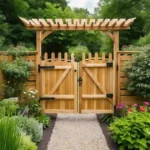
- Flower Garden Aesthetic: Perfect Flowers for Your Garden Bed and Raised Beds
